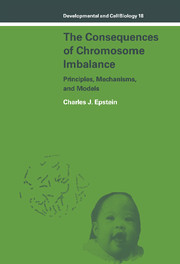Book contents
- Frontmatter
- Contents
- Preface
- Glossary
- PART I INTRODUCTION
- 1 The problem of aneuploidy
- PART II CLINICAL OBSERVATIONS
- PART III THE THEORETICAL MECHANISMS AND ISSUES: THE PRIMARY AND SECONDARY EFFECTS OF ANEUPLOIDY
- PART IV EXPERIMENTAL SYSTEMS FOR THE STUDY OF MAMMALIAN AND HUMAN ANEUPLOIDY
- PART V THREE MAJOR CLINICAL PROBLEMS OF HUMAN ANEUPLOIDY
- PART VI CONCLUSION
- Appendix: Standard karyotypes of man and mouse and human cytogenetic nomenclature
- References
- Index
1 - The problem of aneuploidy
Published online by Cambridge University Press: 14 October 2009
- Frontmatter
- Contents
- Preface
- Glossary
- PART I INTRODUCTION
- 1 The problem of aneuploidy
- PART II CLINICAL OBSERVATIONS
- PART III THE THEORETICAL MECHANISMS AND ISSUES: THE PRIMARY AND SECONDARY EFFECTS OF ANEUPLOIDY
- PART IV EXPERIMENTAL SYSTEMS FOR THE STUDY OF MAMMALIAN AND HUMAN ANEUPLOIDY
- PART V THREE MAJOR CLINICAL PROBLEMS OF HUMAN ANEUPLOIDY
- PART VI CONCLUSION
- Appendix: Standard karyotypes of man and mouse and human cytogenetic nomenclature
- References
- Index
Summary
The human impact of aneuploidy
This book is about a major human problem, one which affects human existence from conception to death. Although sheer numbers cannot tell the whole story, the impact of aneuploidy, in quantitative terms, can be assessed in a variety of ways (Table 1.1) (see also discussions of Golbus, 1981, and of Bond and Chandley, 1983). An exact figure for the frequency of aneuploidy at conception is not available, but it has been estimated to range from as low as 8–10% (Alberman and Creasy, 1977; Kajii, Ohama, and Mikamo, 1978) to as high as 50% (Boué, Boué, and Lazar, 1975; Schlesselman, 1979). The most germane data presently available are those of Martin (quoted in Bond and Chandley, 1983), based on the cytogenetic status of human spermatozoa used for the in vitro fertilization of hamster ova (Rudak, Jacobs, and Yanagimachi, 1978; Martin et al., 1982). In these studies, 8.6% of the human spermatozoa had chromosome anomalies, 5.6% of which were frank aneuploidy. If it is assumed that the frequency of such abnormalities in human oocytes is of a similar or perhaps even greater degree, then the incidence of aneuploidy at conception might be as high as 15–30%. That such a figure is not unreasonable is suggested by the observation that 33% of conceptions prospectively identified by detection of human chorionic gonadotropin in the urine do not survive beyond implantation (Miller et al., 1980).
- Type
- Chapter
- Information
- The Consequences of Chromosome ImbalancePrinciples, Mechanisms, and Models, pp. 3 - 10Publisher: Cambridge University PressPrint publication year: 1986



